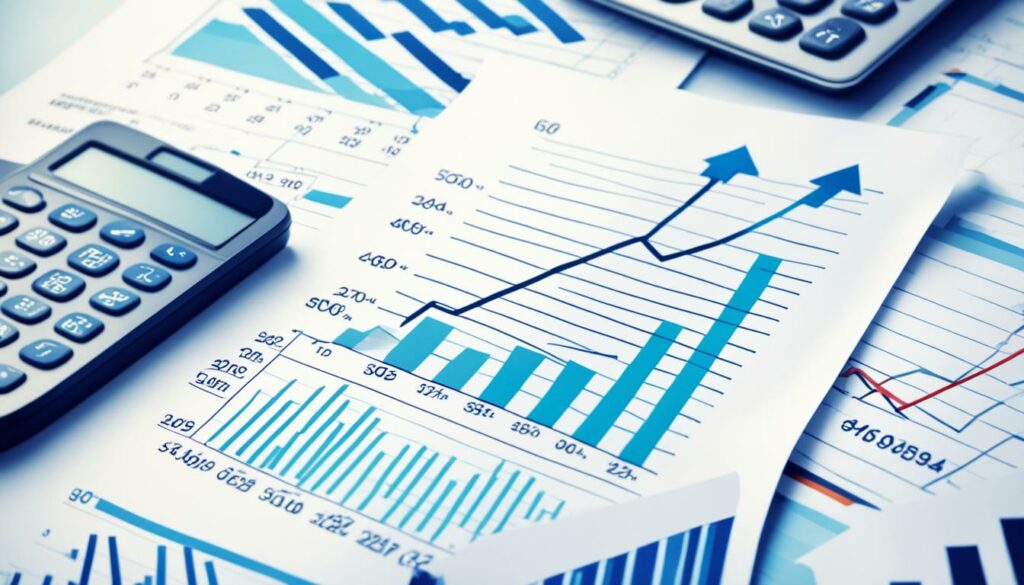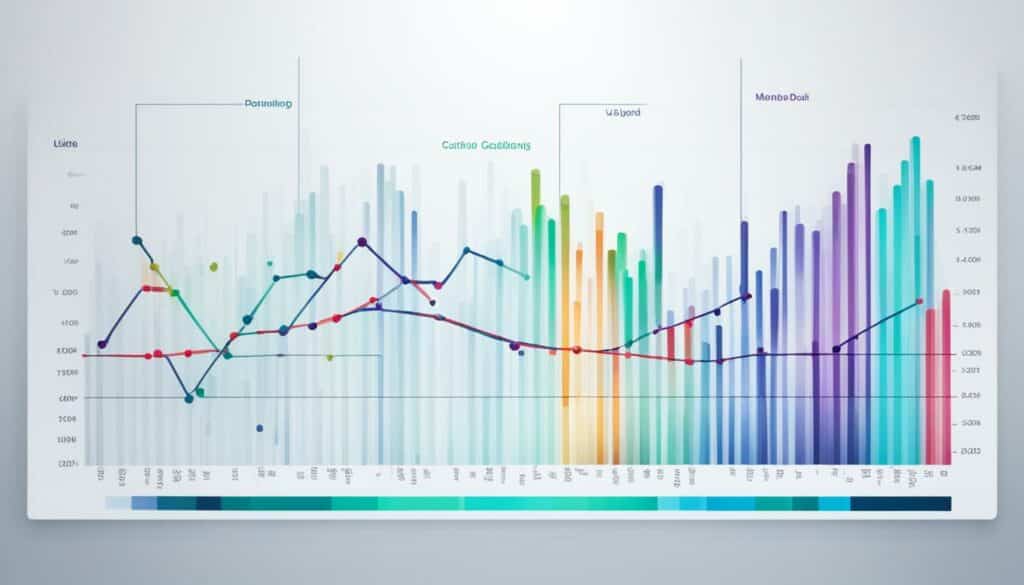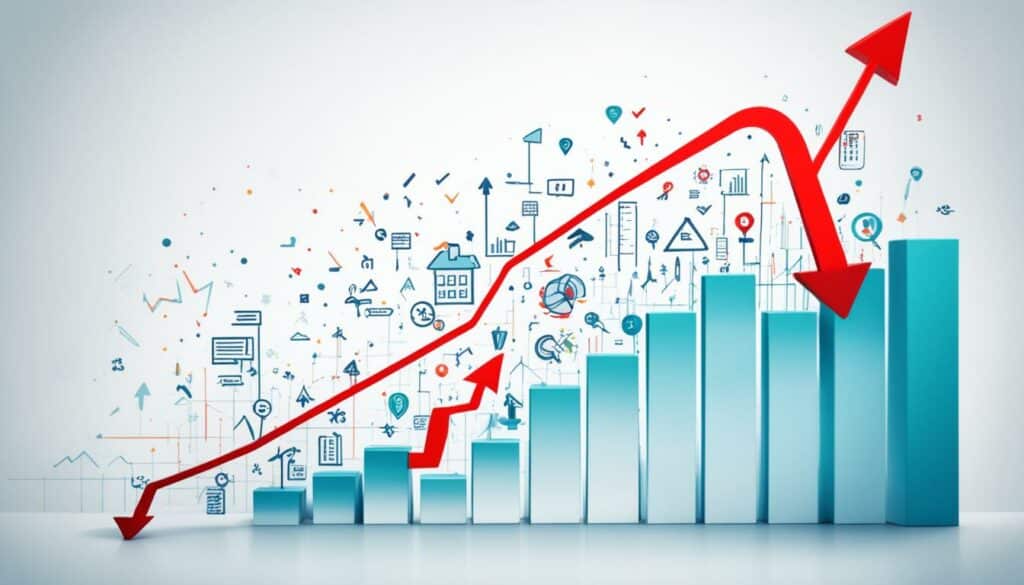Menu

Did you know Time-series Analysis is crucial in many areas like finance and engineering? It helps find trends in data over time. This is vital for making smart choices and planning ahead. Businesses use it to understand long-term trends too.
In strategic planning, price trend analysis is fundamental. It helps businesses and even governments understand market trends. By using past data, they can predict sales and see new chances. They also learn how to make better products. In finance, it guides stock price analysis and investments. Healthcare uses it to watch diseases and plan health efforts.
Doing price trend analysis needs advanced tools. This includes statistical software and predictive models. Companies often get help from data analysts to get the most useful insights.
Price trend analysis is a systematic way to predict market trends. It uses data analysis and looks at past data. This helps businesses make better decisions. They can spot patterns in price changes through statistical analysis. This is key in doing good market research.
Price trend analysis looks at trends over different timeframes. It can be short-term, medium-term, or long-term. It identifies three types of market trends. These are up, down, or staying the same. The main focus is to follow these trends when making investment choices.
Price trend analysis is crucial for strategic planning. It helps companies see when to buy or sell stocks. This lowers the risk and can make the company’s decisions better. Also, it shows market emotions and momentum. This is key for smart business planning.
It’s important to have good historical data for price trend analysis. But, using statistical measures has its challenges. In very efficient markets, it may not work as well. So, it’s crucial to keep updating and checking the data.
| Concept | Details |
|---|---|
| Time Horizons | Short-term, Intermediate-term, Long-term |
| Market Trends | Upward (Bull), Downward (Bear), Sideways (Rangebound) |
| Advantages | Minimizing risk, Improving decision-making, Enhancing portfolio performance |
| Disadvantages | Dependence on data quality, Reliance on historical trends |
It’s crucial to understand different ways to look at market trends. Using a range of trend indicators helps spot patterns over various time periods. This includes both long term and short term trends.
Time-series analysis looks at market trends by looking at historical data. This lets us see patterns and changes over times. It uses past data to guess what might happen in the future, helping to plan for market shifts.
Seasonal analysis focuses on yearly patterns. It’s very useful in retail and tourism for planning stocks and promotions. By knowing when demand goes up or down, businesses can adjust their strategies.

Cross-sectional analysis compares groups at the same point in time. It’s great for understanding market trends by looking at different segments. This method is key in market research, helping to compare different customer groups or areas.
Regression analysis helps us understand the link between different factors. This helps spot how one thing influences another. It’s useful for predicting trends and understanding market relationships based on historical data.
Content analysis studies written or spoken text to find trends. It’s great for understanding what people think and do. This method is very useful for spotting public opinions and new industry topics.
Comparative analysis looks at data from different times or groups to see ongoing trends. It helps give a wide view of market changes. It’s often used to compare companies’ performance in the same period.
| Technique | Application | Benefits | Considerations |
|---|---|---|---|
| Time-series Analysis | Studying historical data for patterns and seasonality | Predict future trends, useful for strategic planning | Requires extensive historical data |
| Seasonal Analysis | Identifying patterns recurring at specific times | Optimise operations for seasonal demands | Not applicable for all industries |
| Cross-Sectional Analysis | Comparing data across different groups | Reveals consumer preferences and behaviours | One-time observations may miss long-term trends |
| Regression Analysis | Understanding the relationship between variables | Predict future outcomes, establish causal relationships | Requires careful statistical interpretation |
| Content Analysis | Assessing textual data for trends | Insights into market sentiment and consumer behaviour | Time-consuming and subjective |
| Comparative Analysis | Juxtaposing data from different times or groups | Broad understanding of market dynamics | Potential for overlooking individual data nuances |
Price trend analysis gives businesses key strategic advantages. It helps spot industry trends and find market chances. It also predicts future trends and keeps an eye on competitors.
Trend analysis helps in risk assessment and can improve how companies make decisions.
Price trend analysis lets companies really understand trend dynamics. This insight covers the short and long-term view. It’s vital for spotting market chances and staying ahead.
It’s crucial for finding strategic growth or investment points. By looking at past data and conditions, businesses find opportunities. This skill can drive marketing strategies and business moves.
Price trend analysis helps in forecasting future market directions. Using tactics like moving averages and momentum indicators, businesses can predict trends. This can keep them ahead of competition.
Good competitor analysis comes from detailed trend study.
It helps companies know what their rivals are doing and spot areas to improve. This keeps them competitive.
Knowing the risks is key for a strong business plan. Trend analysis helps anticipate market downturns. This allows companies to protect themselves from loss.
Price trend analysis deeply improves decision-making. Knowing market trends and risks means smarter choices. This helps in achieving long-term business goals.
Every business is different. Price trend analysis helps create plans suited to each. By looking at relevant industry data, companies can make tailored strategies, leading to success.
It’s a smart way to plan for the future without big costs. By predicting trends, businesses avoid sudden actions and can manage costs better. This results in better use of resources and more profits.
Successful price trend analysis needs a methodical approach. It involves setting clear goals and using accurate data. Then, you analyse this data deeply, focus on important trends, and turn your insights into real strategies.
The first task in price trend analysis is to set objectives and scope. Companies must decide what they want from this analysis. It could be about knowing market trends, predicting prices, or finding new chances.
To categorise data well, you need to collect historical information correctly. This step is crucial because how you classify data affects your analysis’s accuracy. You use approaches like time-series and seasonal analysis.
After categorising the data, it’s time for analysis. Companies use methods like regression analysis to understand the data’s patterns. For instance, regression analysis links different data points to make better decisions.
Once the data is analysed, focus shifts to the key trends. Companies check and confirm these trends are useful. Comparison across various groups or periods is helpful in this.
Finally, insights from analysis are turned into action. This is when companies act on what they have learned. It shapes their strategic and operational decisions.
To understand market trends, we need special tools and methods. These help make price forecasting more accurate. They also give us a deep look into how the market works. By using things like statistical software and data visuals, companies can deeply study the market.
A key method is using moving averages. People who follow trends often look at the 200-day, 100-day, and 50-day moving averages. A sign to buy shares is when the 50-day average goes above the 200-day average. But, it’s time to sell if the 50-day dips below the 200-day. The MACD method is also valuable. It looks at certain lines’ positions to show if a trend is starting or ending.

Methods like regression help a lot too. They check how different factors are connected. Google Trends and SEMrush’s Market Explorer are great for understanding the market. They can tell us what people are searching for and what our rivals are doing.
Knowing the types of market trends is crucial. There are up trends, down trends, and flat trends. Investors use momentum tools and lines to make the most of these trends. The RSI can tell when a stock is overpriced or underpriced, making our trend projection more accurate.
It’s good to think about the good and bad of these tools. They can find good times to trade and reduce the chances you’ll lose money. But sometimes, the data might not be right. Even so, with the right set of tools, you can turn data into smart choices, helping your business grow.
| Tool | Monthly Cost | Main Features |
|---|---|---|
| Google Trends | Free | Search term popularity |
| Qualaroo | $80 | Customer insights |
| Answer The Public | $9 | Google search analysis |
| BuzzSumo | $79 | Competitor social profiles |
| SEMrush Market Explorer | $119.95 | Competitor SEO strategies |
The success of price trend analysis really depends on the quality of the data. Problems with data quality can make the results less reliable. Issues like incomplete or inaccurate data can mess up our predictions. This happens because trend analysis uses old data to guess what might happen in the future.
Trend analysis also has its limits when it comes to guessing future prices. It looks at the past to assume the future. But, markets are always changing. Because of this, what happened before might not happen again. The ability to predict is then stuck with thinking old patterns will keep happening.
Markets keep changing because of many things like money shifts, new rules, and big events. These outside factors can mix up what we thought we knew about trends. It’s harder to guess right because of these changes.
Figuring out what the stats mean is not easy either. It takes a lot to really understand all the numbers and how they relate. This can lead to different views among experts. This might cause not everyone to see things the same way.
“The reliance on historical data for predictive outcomes can sometimes lead analysts astray, especially if the data quality isn’t rigorously ensured.”
Some critics say the markets are too good at using information in their prices. This might make trend analysis not as useful. Instead, they suggest looking at the core of companies for better market clues.
Even though trend analysis can be helpful, its weaknesses should be recognized. Not everyone will get the same results from looking at the numbers. And, it might ignore surprises that can shake the market. That’s why it’s important to use different methods together.

Price trend analysis is key in many sectors. It uncovers patterns that predict big outcomes. This happens in fields from finance to healthcare.
Those in finance look at historical stock prices for trading clues. They spot rising or falling trends to make smart investment moves. Governments, on the other hand, consider GDP growth to craft effective policies.
Sales tactics rely on past sales data. It helps tweak marketing plans for better customer reach. Schools use it too, watching student data to support those who need it most.
Health pros observe disease patterns to notice outbreaks sooner. This guides health strategies. Plus, weather data analysis aids in planning for climate change.
| Industry | Application | Outcome |
|---|---|---|
| Finance | Stock Price Analysis | Informed Investment Strategies |
| Government | Economic Indicator Analysis | Effective Policymaking |
| Sales & Marketing | Sales Data Analysis | Optimised Marketing Strategies |
| Healthcare | Disease Trend Analysis | Public Health Strategy |
| Education | Student Performance Evaluation | Targeted Interventions |
| Climate Studies | Temperature Data Analysis | Climate Policy Development |
Technology firms predict market shifts using trend analysis. It gives them an edge. Meanwhile, logistics teams watch stock levels to improve delivery speed.
Price trend analysis sharpens strategies. It makes business and government plans more precise. These tools are vital for the future, in a world driven by data.
We’re looking at how big companies have used data to make smart decisions. Their moves have changed the game in the business world.
Amazon boosted its sales by 25% in three months with new marketing tools. This effort helped them earn 18% more from ads that target specific customers. It also kept more people coming back, raising their customer return by 12%.
McDonald’s upped their game on social media. After using data, they saw customer interest grow by 30% online. This approach, combined with smart market strategies, made customers stick around 10% more.
Zara showed how smart inventory planning pays off. They cut inventory costs by 20% using data. At the same time, they increased their overall income by 5%.
These stories prove the power of using data. When companies make decisions based on real information, they get ahead. They improve their market standing and do better than their competition.
| Company | Outcome | Impact |
|---|---|---|
| Amazon | 25% increase in sales | Advanced marketing analytics |
| Amazon | 18% rise in revenue | Personalised ads |
| Amazon | 12% improvement in customer retention | Data-driven planning |
| McDonald’s | 30% increase in social media engagement | Data-driven social media strategy |
| McDonald’s | 10% rise in customer retention | Enhanced consumer interactions |
| Zara | 20% reduction in inventory costs | Predictive analytics |
| Zara | 5% increase in revenue | Data-driven inventory management |
Data visualisation is key for understanding price trends today. It helps businesses easily see patterns in complex data. This makes decision-making faster and smarter, thanks to clear data.
Seeing and explaining market trends depends on good data visualisation. Things like trendlines and heat maps show changes in prices and feelings in a market. They make data easier to understand, which helps in planning well.

Tools like Tableau and Google Data Studio are vital for understanding trends. They let companies make visuals that everyone can interact with. This turns tough data into useful market insights.
Getting your message across clearly is crucial. Using smart techniques like LOESS and splines makes trend visuals more accurate. Moving averages can smooth out small bumps, giving a clearer picture of the big trends.
| Tool | Usage | Benefits |
|---|---|---|
| Tableau | Dashboards, interactive charts | Advanced analytics, user-friendly |
| Microsoft Power BI | Real-time data analysis | Integration with Microsoft products |
| Google Data Studio | Collaborative reports | Free to use, integrates with Google Analytics |
Using these tools improves how businesses understand data. It lets them easily spot trends and make the right choices.
As a seasoned market strategist, combining price trend analysis with other market research methods is crucial for businesses. It offers a complete understanding of the market. This way, companies can stay a step ahead in a competitive world.
Trend analysis looks at market patterns over different time periods. It blends well with other research approaches like surveys and looking at competitors. This mix gives a full picture of what’s happening in the market.
Many traders focus on strategies like using averages and momentum to spot market movements. Yet, this can be improved by adding other data sources. For example, using trendlines with statistical analysis can help find the best areas to invest.
For instance, using past price and volume data can help spot market trends and behaviours. This method also aids in finding the right times to buy or sell, improving investments.
Integrated trend analysis offers a full look at the market. It helps in making strategic decisions that are more detailed and proven by data. This leads to smarter and more flexible business moves.
The way we understand and predict market trends is changing fast. Now, we rely on predictive modelling, AI, and machine learning to make better guesses about the market. This means our methods are becoming more accurate and quick to catch changes in market behaviour.

Before, we mainly looked at trends in three time frames: short-term, intermediate-term, and long-term. Thanks to advanced algorithms and the use of big data, we can now make real-time predictions. This lets us spot trends faster, helping us plan our strategies better.
We’re also using more advanced tools in trend analysis. Things like Moving Averages and Momentum Indicators help us understand market momentum. With these, we can figure out the best times to buy or sell more precisely.
But, there are some downsides to these new methods. Depending too much on past data and the way we interpret stats might lead to wrong predictions. Critics also warn about unexpected events changing market trends. However, the advantages, like making better choices and improving portfolio performance, show us the benefits of these new approaches.
To use these new trends well, understanding their strengths and weaknesses is key. Keeping up with new technologies and being flexible with our predictions helps us get the most out of trend analysis. This leads to smarter business decisions in the end.
Knowing how price trends work is key for planning in the market. Various things called price determinants greatly influence these trends. They include economic signals, how people feel about the market, and things happening outside the market.
Actions by the government, like its money and tax policies, affect the economy a lot. They can change growth, the amount of interest you pay, and the way money moves around. The strength of a country’s money and economy is also tied to how much it trades with others. Usually, the real worth of stocks is based on key facts, like how much they earn and their price compared to that. These financial points all work together. They shape what happens in the market today and what people think might happen tomorrow.
What people guess and hope for really matters in the market. This is because the way they feel affects prices now and later. When investors think a government move or a big trade will make prices jump or fall, that’s speculation. These thoughts and feelings, shared by everyone in the market, can be stronger than the actual facts. They can also largely change the prices of stocks and other investments.
Big events outside the market change trends too, like important news from the government, new trade rules, or key changes in society. For instance, the US Federal Reserve’s decision about interest rates can stir up big changes. Another thing, the balance between how much of something there is and how much people want can affect the prices of both products and investments. These ‘outside influences’ help us understand the bigger picture of why prices move as they do.
| Key Factors | Influence on Price Trends |
|---|---|
| Economic Indicators | Government policies, international transactions, and market fundamentals. |
| Market Sentiment | Speculation, investor expectations, and collective psychology. |
| External Influences | Regulatory changes, news releases, and supply-demand dynamics. |
Price trend analysis is a useful tool for making wise choices in investing or running a business. It shows when to buy or sell to make more money. Yet, it also comes with its downsides. Let’s look at the good and the bad of analysis advantages to get a full picture.
Looking at price trends helps find chances to make a good purchase or sale. This is done through checking past data to understand the market’s direction. It also lowers investment risks by making market trends clearer. This helps in making better choices and improving your investments. Plus, it looks at big picture data like financial reports and economic signs. This gives a solid basis for knowing likely futures and making plans with strategic foresight.
However, this method is not fool-proof. Its success heavily relies on having good and complete data. Using the wrong or missing data can lead you astray, making investing riskier. Also, purely looking at past prices doesn’t always predict future prices. It might not catch key changes, like new management or laws, that can shake up the market. So, while it can give a peek into the future with strategic foresight, it’s wise to be careful. Always think about what else might be affecting your market.
It’s important to balance out these inherent disadvantages with the benefits when using this tool. Knowing its strengths and weaknesses helps both companies and investors. They can make smarter decisions and avoid some risks by being aware of the whole picture.

In conclusion, studying price trends is a vital tool for planning. It helps businesses predict what the market might do in the future. There are three main trends businesses look for: when prices go up (bull market), down (bear market), or stay the same (rangebound market). Knowing these trends helps businesses plan better and deal with market changes.
Using different methods, like looking at average prices or patterns in charts, can make decisions stronger. Computer analysis in trend following helps pick the best investments. These tools reduce risk and help businesses make better choices, giving them an advantage.
But, price trend analysis isn’t perfect. It relies on old data, which might not always be right, and it doesn’t show the full future picture. According to the efficient market theory, all information is already in the prices. This makes some doubt the value of trend analysis. Still, there are many pluses, such as spotting when to buy or sell or understanding market moods.
In the end, studying price trends gives businesses key insights. It helps them spot chances and avoid dangers, leading to growth and safety. Using this method alongside other strategies helps businesses flourish and make strong choices, guiding them towards long-term success.
Price trend analysis helps predict how markets and consumers will behave. It looks at past data to spot trends. This aids businesses in making smart choices.
In strategic planning, understanding trends is vital. Price trend analysis uses old data to make future predictions. This makes forecasting sales and spotting market chances easier.
Understanding price trend analysis means knowing about data analysis and market research. You should know about price changes and recognising patterns.
There are many trend analysis techniques like time-series and seasonal analysis. Each one gives different insights into market behaviour.
Time-series analysis checks data over time to find trends. It’s great for understanding how things change over the years.
Seasonal analysis looks at trends that happen at certain times. It’s key for industries like retail, which see sales change with the seasons.
Cross-sectional analysis compares data between different groups. Businesses do this to see market segment differences.
Regression analysis looks at how one variable affects another. It helps in predicting trends by analysing many factors.
Content analysis studies written or spoken language to find trends. This helps understand public opinions and behaviours.
Comparative analysis looks at data from different times or groups. It helps see how well a business is doing compared to others or to previous times.
Price trend analysis helps businesses in many ways. It’s useful for predicting the future, understanding competitors, and making better decisions.
It does this by giving a deep understanding of what’s happening in the market. This helps businesses make decisions that fit the current situation.
To use trend analysis in planning, you must set clear goals. Then, gather and analyse data to find trends. After that, you can make a strategy based on your findings.
Businesses use various tools for trend analysis. This includes software for statistics, tools for visualising data, and modelling to predict trends.
Trend analysis faces challenges like bad data and relying too much on the past. It can be hard to predict all market changes.
Price trend analysis is used everywhere from finances to health care. It helps see trends early for better investing and planning.
Data visualisation is key for making complex data easy to understand. It helps businesses see and act on trends quickly.
Look out for more use of artificial intelligence and predictive models. These technologies will make trend forecasting more accurate and efficient.
Price trends are influenced by many factors like economic changes and market feelings. They can also be affected by new laws and social trends.
It brings many benefits like spotting good moments to buy or sell, and understanding market directions. It also helps in saving costs.
However, using trend analysis can have downsides. It might not predict everything due to bad data or not considering all external factors. It also heavily relies on the past for future ideas.